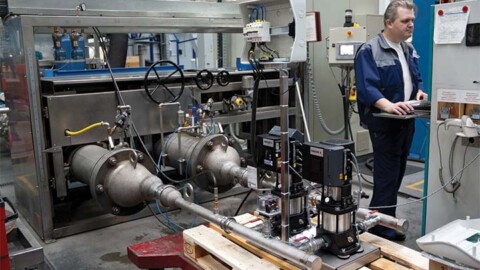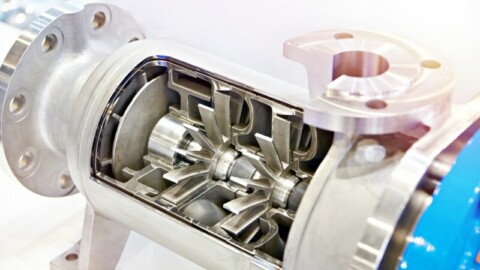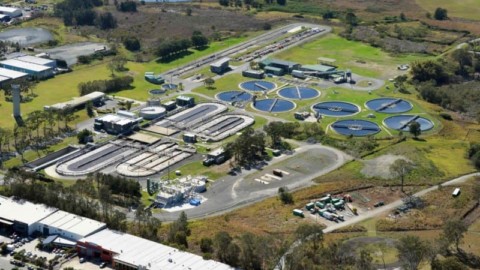By Dominik Fry, P.E., Engineered Software
One of the most common misconceptions I hear is that a pump is rated for a certain flow rate and that the pump is bad if it does not deliver. While this may be true when you are discharging to a spillway and there is little resistance, most pumping systems are much more complicated. I was recently dealing with a situation where there were multiple pumps in parallel and the operators and engineers were confused as to why they were not getting the flow or pressure they thought they should. In fact, they were only operating with one of the two cooling towers available due to the lack of flow. The system had been expanded many times, and they were considering expensive repairs to the pump manifold that would total more than $100,000.
Since the system had been in operation for many years, there were not many places to collect data. There was a pressure gauge on the pump manifold. It was known that the cooling tower would overflow at 2,200 gallons per minute (gpm), so a flow rate of around 2,000 gpm was assumed. While we looked at modelling the entire system, the crux of the problem can be seen in just the model of the pump manifold which we will cover here. There were two larger pumps on the ends (Pump 4070) with three slightly smaller pumps (Pump 830) in the middle. This can be seen in Figure 1 operating at just over 82 pounds per square inch (psi). Under normal operation, all these pumps were in operation. The operators thought that something must be wrong, though, because they really could not see a difference in discharge pressure when one of the smaller pumps was turned off.

Figure 1: Pump manifold under normal operation (Images courtesy of the author).
When the system was modelled with one of the smaller pumps shut down some interesting results were realised. Shutting down the middle pump resulted in a pressure drop at the gage of less than 2 psi as seen in Figure 2. This drop could easily be missed on a gage or not even noticeable depending on its accuracy. This also shows that it may not be the rest of the system at fault, or even the manifold itself, but how the pumps were interacting together.

Figure 2: Pump manifold with one pump shut down.
Pump professionals will agree that it is generally not a good idea to have different sized pumps operating in parallel. This indeed is one of those scenarios. At one point during an expansion, the plant decided they needed more flow and installed the third small pump expecting to get the rated flow, however it appears the efforts were largely wasted. So why is it that the extra pump did not deliver the desired results? For the answer, we need to look at the pump curves.
The larger pumps certainly may have been overpowering the smaller pumps, but there is another important aspect to observe. Under normal operating conditions, the smaller pumps were putting out just over 177 feet of head. This can be seen in Graph 1, where the impeller has been trimmed to 7.125 and the pump is operating far to the left of its best efficiency point (BEP). While the desired output from the pump was around 600 gpm, in reality the pump was only putting out just over half this amount. We can also see that the pump curve is very flat at this point, so we should not expect a large change in pressure with a change in flow rate.

Graph 1: Pump 830 under normal operation.
When we investigate how the pump is operating while one of the pumps is shut down, it confirms that there is a small change in pressure due to the change in flow. While the total system flow is the same, the pressure barely drops. The small pump’s flow rate changes from around 350 gpm to almost 400 gpm. Because it is operating at an almost flat section of its curve, barely any change at the pressure gauge is observed. If we were to repeat this process with the larger 4070 pumps, we would see the exact same thing.

Graph 2: Pump 830 with one pump shut down.
This scenario demonstrates exactly why more attention needs to be paid to pump curves as opposed to just ordering more pumps. To be clear, there is no issue with the specific pumps, just how they were applied. Whenever you have dissimilar pumps in parallel, they can work together or fight each other depending on the system. Here, I even ran the simulation with all five pumps the same.
Where the pump was operating at BEP on its curve shifted, but the manifold exit pressure did not change much. If all the pumps were the larger Pump 4070 model, the exit pressure would only increase by about 1 psi total to 83.5 psi. This would be a bad scenario because it would lead to an overall power increase and the pump would be so far back on its curve as to almost be outside of the manufacturers recommend operating range. Even with all five pumps changed to the smaller Pump 830 model, the pressure would only drop about 2 psi down to 80.4 psi.
While, at this point, it may seem that an entirely new pump is needed, there may be more inexpensive and easier items as well. Remember that the impellers were trimmed to where there is the potential of ordering new larger impellers. When modelled, this could significantly increase the pressure and flow rate, provided the motors can handle the extra load. This is why I generally turn to a quick model of a system after doing an initial evaluation. You can get a good idea of how everything is interacting, without having to spend any money on new equipment. This in itself can avert some costly mistakes.
















